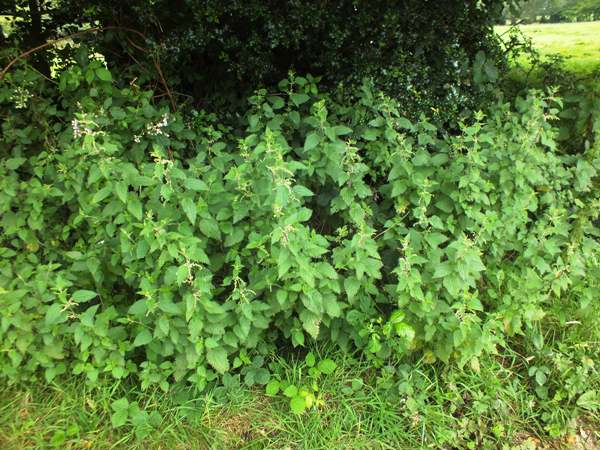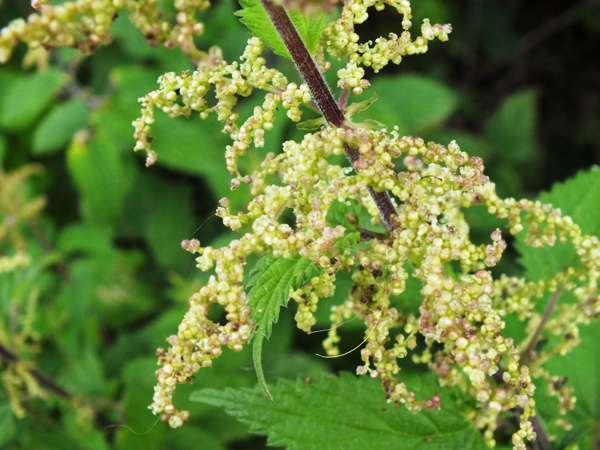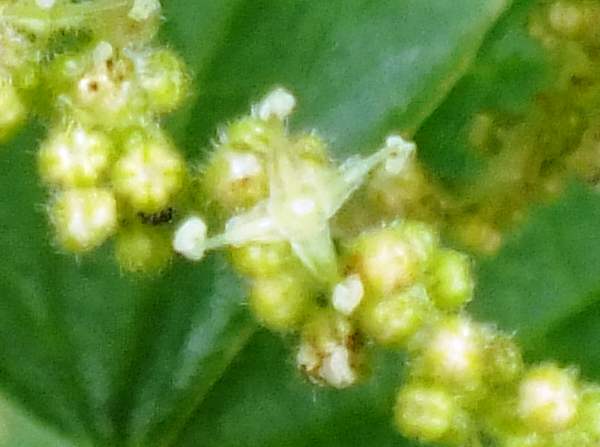Trees Birds Mammals Fish Amphibians Reptiles
Wild Algarve
Bookshop
Urtica dioica - Stinging Nettle
Phylum: Magnoliophyta - Class: Equisetopsida - Order: Rosales - Family: Urticceae

Sometimes referred to as a weed of habitation, this plant is found throughout the UK and Ireland.
Description
Stinging nettles are perennials and grow to typically 1m in height but can reach 2m in suitable damp, shaded locations. In winter the plants usually die back completely. Leaves are elongated heart shapes and have strongly serrated margins and are covered in hairs, some of which act like hypodermic needles, breaking off and injecting stinging chemicals into anything (and anyone!) contacting them.
The male and female flowers occur on separate plants. Both flower sexes are green with yellow stamens, but the male flowers often have a purplish tinge and the female flowers tend to droop much more than the male flowers do..

Above: Male flowers of Urtica dioica often have a purplish tinge

Above: Male flowers of Urtica dioica
Distribution
Urtica dioica is found throughout Europe, where it is particularly common and widespread in the north. Its range extends southwards into North Africa and estwards into parts of Asia. This species (of which there are several recognised subspecies) is also found in North America.
Habitat
Stinging Nettles are most commonly seen on the edges of woodland, roadsides and some river banks, but they readily colonise any wasteland and sometimes invade permaent pastures.
Plants of Urtica dioica bear their flowers throughout the summer months.
Etymology
The specific name dioica means 'two houses', a reference to the fact that male and female flowers grow on separate plants.
Uses
Nettle wine is made from the young fresh shhots of Stinging Nettles. If you do get stung by nettles, rubbing the affected area with a dock leaf is recommended to alleviate the pain.
The Stinging Nettle plants shown on this page were photographed in West Wales.
Sue Parker's latest ebook is a revised and enlarged edition of Wild Orchids in The Burren. Full details here...
Buy it for just £5.95 on Amazon...
Sue Parker's new ebook is a comprehensive and fully revised edition of her acclaimed field guide to the Wild Orchids of Wales. Full details here...
Buy it for just £5.95 on Amazon...
Please Help Us: If you have found this information interesting and useful, please consider helping to keep First Nature online by making a small donation towards the web hosting and internet costs.
Any donations over and above the essential running costs will help support the conservation work of Plantlife, the Rivers Trust and charitable botanic gardens - as do author royalties and publisher proceeds from books by Pat and Sue.